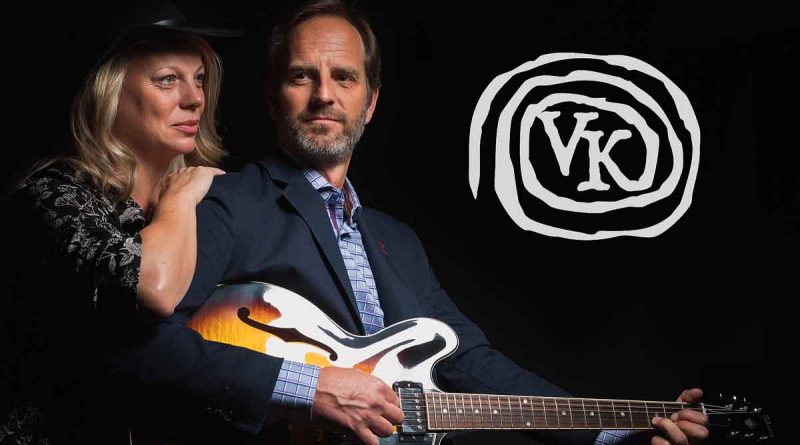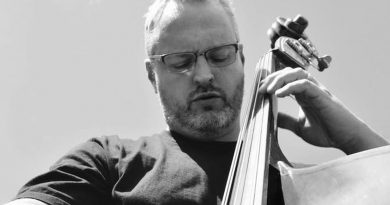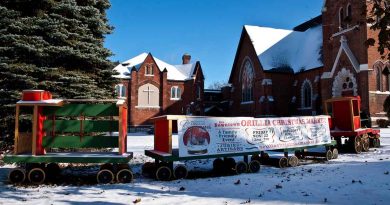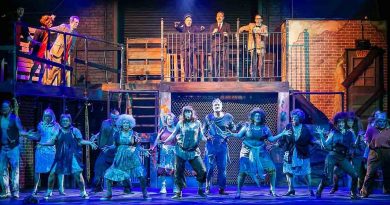It’s All About Love
By John Swartz
Orillia and area has had only one studio where musicians could record their music, but in the last couple years two more have been established and one more is soon going to be up and running. It’s time to have a look at this development, one studio at a time.
Steve and Marni Van Kessel created their 112 Records studio to record their own music. On stage they are VK and their band is known as The Narrows for the first album and Legends of The Deep for the third. The middle one was simply under the VK name.
The story has several threads and should, as most stories do, begin at the beginning.
“I was a songwriter and I did acoustic stuff, but no I never had a full band. I was a late bloomer I was kind of the campfire troubadour, the open mics and stuff like that,” said Steve. “I wasn’t in the music program at school.”
“I did some vocal training and sang in all the music festivals,’ is how Marni described her involvement with music at a young age. “Then we got married and life just kind of took over and all that was sort of on the back burner, other than singing the kids to sleep.”
Both concentrated on their careers. Steve and his sister, Susan Peacock, took over Parry Automotive from his father. Marni was a registered nurse and moved into administration; she currently is the regional director of the North Simcoe Muskoka Ontario Renal Network and program director for Soldiers’ Memorial Hospital’s kidney and cancer care and genetics program.
It will be seen their business backgrounds influenced the musical success they have. It’s fair to say, as with many people who go down the music rabbit hole as teenagers, it never really leaves the system when life gets in the way. More on that further down, but for now the concrete example is Steve’s experience.
“The actual defining moment was Marni bought us some tickets for a CBC produced show down in Toronto called the Songwriter’s Series. The one we went to was Ian Tyson and Jim Cuddy,” said Steve. The format was play a song, sit on the couch with Laurie Brown and talk about the music and career. One person in the audience, Steve, was paying close attention.
“I thought, you know what? I haven’t been playing much at all for the last few years. These guys just totally awoke something in me because everything they were talking about, the inspiration for the songs,” struck a chord, and “I had a whole drawer full of songs. They were just me and my acoustic guitar.”
He opened that drawer. Started tinkering with the music again and, well, the rest is history. It was a mutual decision, but Marni’s involvement was more supportive of the idea for Steve to pick up where he left off on the rabbit hole journey from years ago.
“So I came back and met with a few good friends that were players. That’s when VK and The Narrows came together and that just kind of reinvented the passion.” Plans were made to record a few songs.
“It awoke the passion and really gave me vision on where to start going with this. I think it was 6 or 8 months later that I awoke the passion in her. I knew Marni sang and she did what she did, but we never really explored it together,” said Steve.
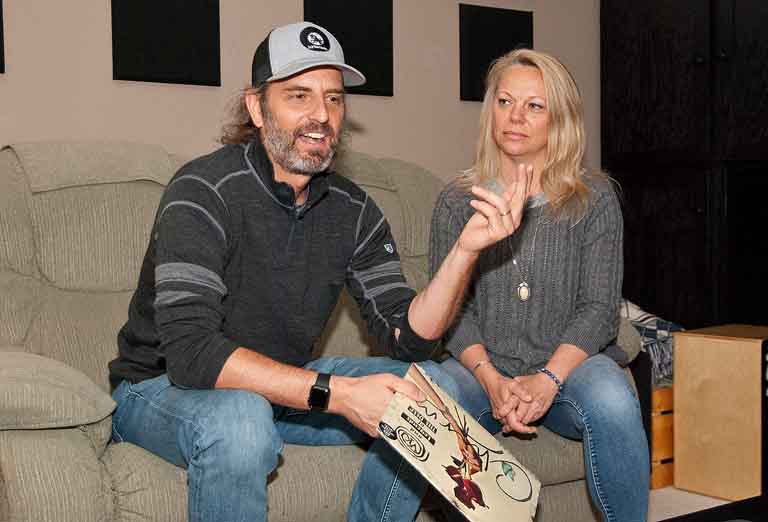
Up to then, Marni was organizing, being, maybe it could be said, a band mom. That changed.
“We were laying tracks down at Steve Henry’s studio (in Warminster) on the song Living In The Dream on Doing Just Fine (album). We had a couple other girls who were singing with us as well and Marni was at the studio all day, taking pictures,” said Steve.
“I listened to these guys rehearsing, loved the music,’ said Marni. “They were there to record for the weekend. I wasn’t part of the band. I was there just taking pictures and video trying to capture it all for them. I’m a huge music fan and everything, hanging out spending time. Doug (Meredith,
band member) said, “why aren’t you singing with us?” Next thing you know, Steve Henry said, “well, get up to the mic, let’s go.””
So the Van Kessels, as musicians, became a thing, and for Marni it was like completing a circle forming part of a larger Venn diagram.
“It was very strange. It was a little bit of a serendipitous moment, like Déjà Vu, I’m stepping up to a mic in this hall where I started vocal training years ago,” Marni said.
Forming the Company
Recording is just half the battle. Being in the music biz has more halfs than Yogi Berra can site in one sentence. Who is going to hear the music, which comes after what format will the music be on, and both lead to how can people buy the music? Enter the label the Van Kessels started to manage the business side. They’ve done quite well, or rather Marni has done well. One can spend a great deal of time surfing the internet, page after Google page of links to reviews and places to find the music – other than at their own website.
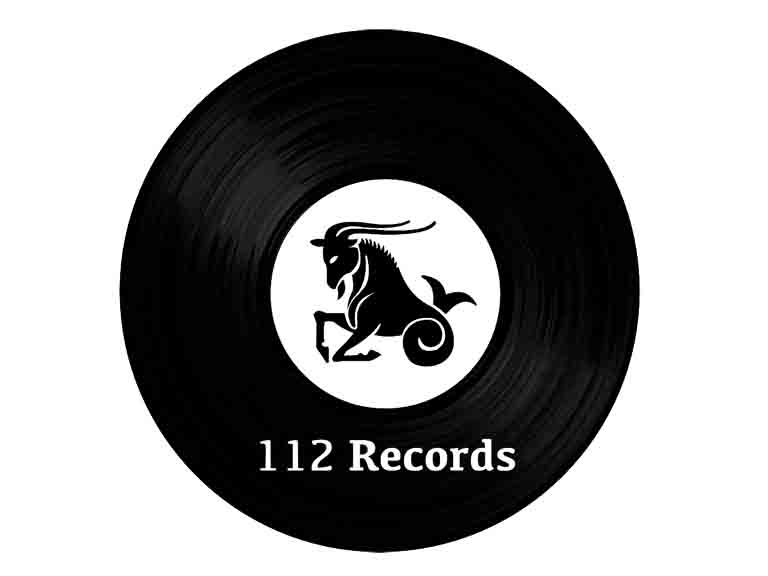
“We’re on about 40 or 50 different – Spotify, Google Play, Amazon, Pandora – all of them really that are available,” said Steve. “There so much static. There’s so much coming at everyone. To get the attention of those playlists, you’ve got to get the playlists that have a million listeners to really get traction. That’s where Marni’s phenomenal, all that type of promotion of putting the music out to the bloggers.”
“You feel like sometimes you’ve got to chisel and hammer, you’ve got to keep chipping away at it because there’s so much music out there. Every little piece is a bit of static and you’ve got to creatively find a way to get people’s attention and slow them down to actually listen to something,” said Marni.
All the work got their middle album, Terms and Conditions, nominated for Album of the Year and Song of the Year on the Blues and Roots Radio Worldwide earlier this year.
But one thing needed to be done to round out the music experience, which directly affected the success of the Terms and Conditions album.
“The first thing I ever recorded was the Orillia Song way back when. That was working with Lance (Anderson), that was a great experience working with him. For Doing Just Fine, our first album with VK and the Narrows, I didn’t have the studio,” said Steve. While recording elsewhere worked out well, he wanted more control over the things all musicians experience.
“My first experiences I had going into the studio, you’re on the clock, you’re paying for it, you’re in an environment that’s not comfortable, it’s like sterile almost, and you’re just not capturing what you want to capture,” said Steve.
The Studio
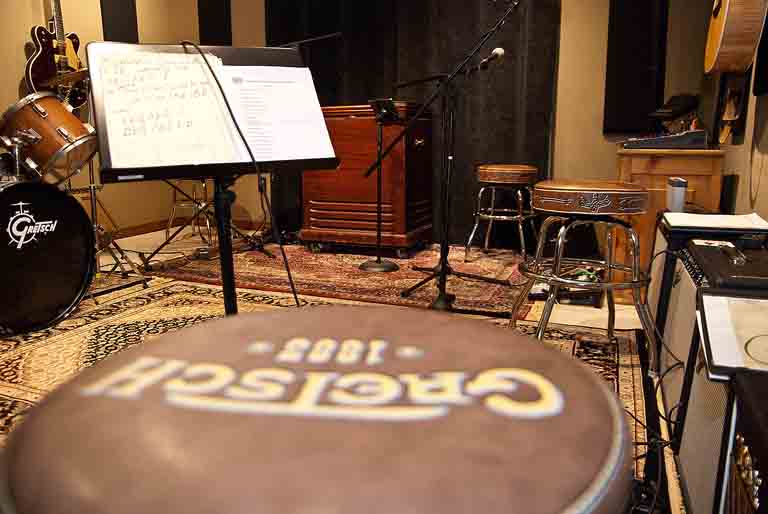
So, 112 Records became a label and a studio. They had the perfect place for it too, with the kids being off to college and such. When you enter, you know it’s not the rec room because of the drums, amps and other paraphernalia taking up half the room. But if those weren’t there it would be just like any other rec room, but with tastefully mounted guitars, lots of guitars, on the walls instead of paintings, and squares of tastefully done geometric fabric wall hangings, a lounge pit and TV. There is no big console for mixing, no speakers or racks of electronic gear.
“If you come in here when we’re recording; if we’re recording drums it looks very different with the overhead mics and the mics all over,” said Marni. “We put up the baffles all over the room and with the extra carpet and the door closed, head phones on everybody, usually the amps are down the hallway in separate rooms.”
It’s a home after all, and all that stuff magically appears when the musicians show up. The Van Kessels managed to put the electronics they needed to record into what someone from a production crew would call a flight pack. It’s a small case on wheels with internal hardware to mount electronic gear and they used every square inch of it.
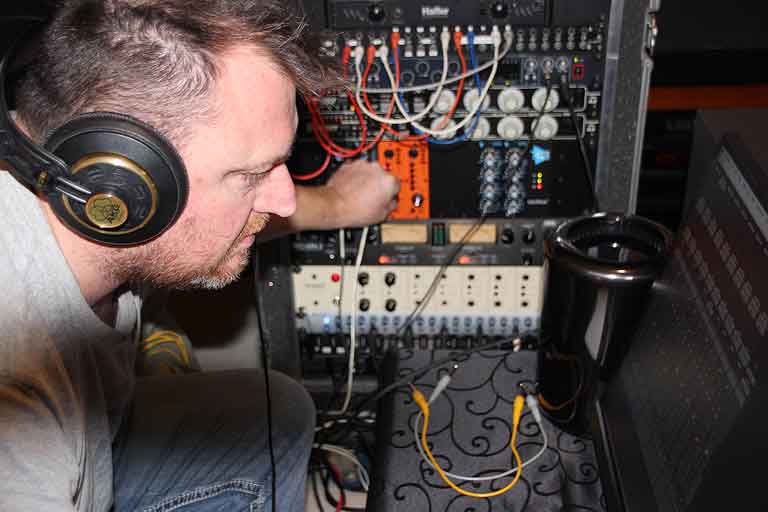
“A very important factor is we have another partner in it. Mac McGill, he’s the recording engineer. He oversees as chief engineer,” said Steve. McGill learned sound production at Fanshaw College and spent some time working in recording studios in Los Angeles and Toronto before returning to Orillia. He’s the one who configured everything a person could need to capture basic tracks to later import to a computer for processing and mixing.
Symbolism is a recurring theme with the Van Kessels. Steve and Mac discovered they have the same birthday, January 12, so 1/12 becomes 112, and Marni said her astrological sign is opposite Steve’s and claims part ownership of the numeral 2 in the label name. Back to the recording gear.
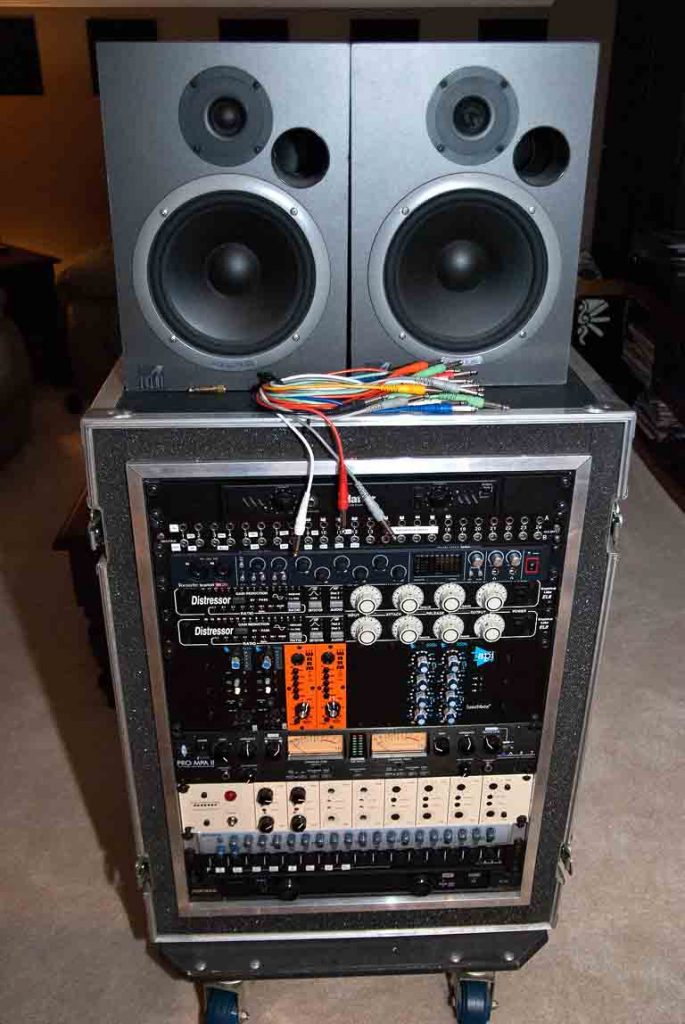
“Basically it’s a (mixing) board broken down. It’s all mic pre’s (preamplifiers), compressors, interface and everything. It’s portable, so I can take it wherever we want to actually capture the sounds we’re looking for, but we do 90% in this room because this room has an incredible sound,” said Steve. They did take it on a road trip to St. Paul’s Centre to record piano parts for a couple of songs.
A nice finishing touch is a set of padded stools for guitar players to sit on that bear the Gretsch label, which we’ll pretend for a moment is to tie the room in with the Gretsch drums and not Steve’s prized Gretsch Chet Atkins Country Gentleman model guitar.
With the flight pack’s capability, they can record everything at once, just like the old days, which they do on first pass just to get the drums and bass recorded; then they can go back and record all the other instruments being used on a particular song, and the vocals, as separate passes. This can possibly lead to complications when playing live.
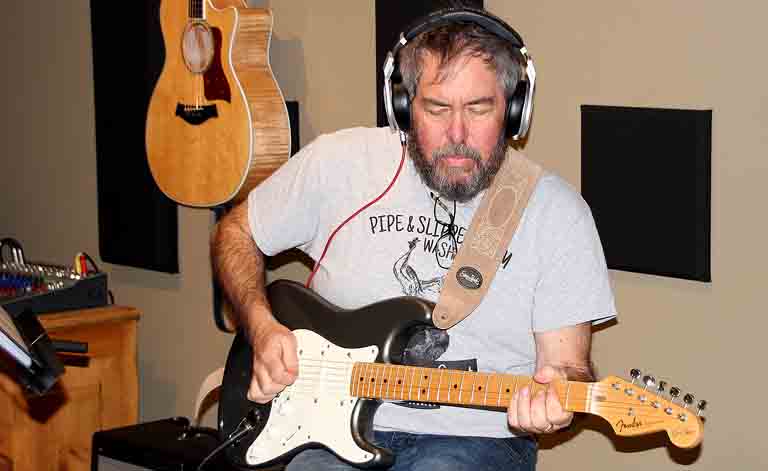
“If you talk to any of the guys in our band they’ll tell you Johnny Lebarr, he’s one guitarist…” said Marni.
“Orchestra,” Steve interjected.
“A lot of his tracks are layered,” Marni continued, then adding the question posed to Lebarr anyone would naturally ask, “”John, how are you going to perform that live?” “Oh, I’ve got it,”” Marni said was his reply.
Everything about the studio says quality to the eyes, and to the ears when hearing the finished product.
“We’ve had so much success with what we’ve developed out of this studio and we’re proud of what’s come out of it and the comfort of the environment. How it’s set up and how we go about it I think has been a big part of that success. It’s not an open door, swinging open and shut with people coming and going. We want to keep that intimate so we can get the most out of the artists we are working with,” said Steve.
Bands and musicians don’t recording every day, so the investment could sit there most of the time waiting for the next dusting.
“We started the label to really promote our own music and get it out there. The studio is kind of unique to have as part of the label. It’s a closed studio, but we now have three artists, including us (and Michael Martyn and REAY).”
“The artists we are working with, all of them have essentially become really good friends and extensions of our family in our home. When we set up to record here on any given weekend, we hunker down here. Food is made here, we eat together, we drink together, we record together, it’s an all-day, we get lot out of everybody,” said Marni.
The conversation turns to an aspect of what the Van Kessels have started that was a missing factor in the Orillia Music scene for many years. There is no producer living in the area and producers are essential for bands to create the best recordings of their songs. Sure, one can point to Lance Anderson, and they’d be correct, he is a producer. While he has worked with a couple of Orillia musicians, much of the work he does is with musicians in Toronto or further afield. The Van Kessels are looking around the neighbourhood for projects to involve themselves in.
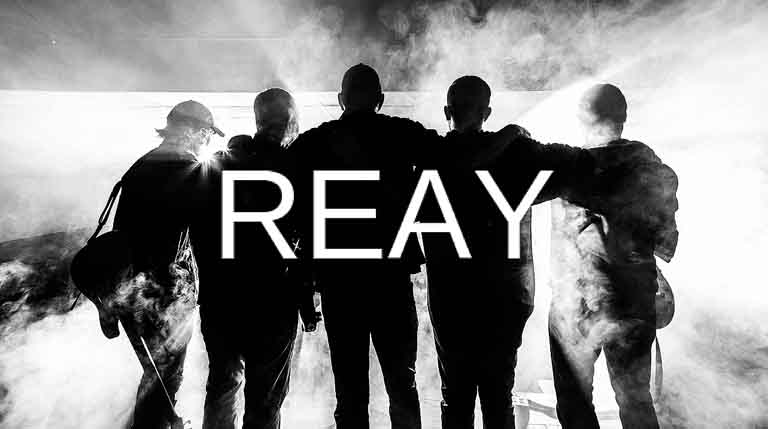
REAY is one of those. It’s Sean Murray’s project, and the band name, and he’s also the keyboard plater in VK and Legends of The Deep. The REAY project was recorded with similar circumstances to how the Van Kessels recorded Terms and Conditions.
“The album was done with session musicians. All the guys that are listed (Sean’s son Bayze, Ryan Smith, Matt Copeland and Chad Van Deusen) will be performing the album live, but they are not on the album. Sean did it as a solo project before REAY was formed, kind of like what we did with Terms and Conditions. We formed Legends of the Deep to go out and promote the VK Terms and Conditions album and the rest is history, we just hit it off so well that this album came out of it,” said Steve of their newest.
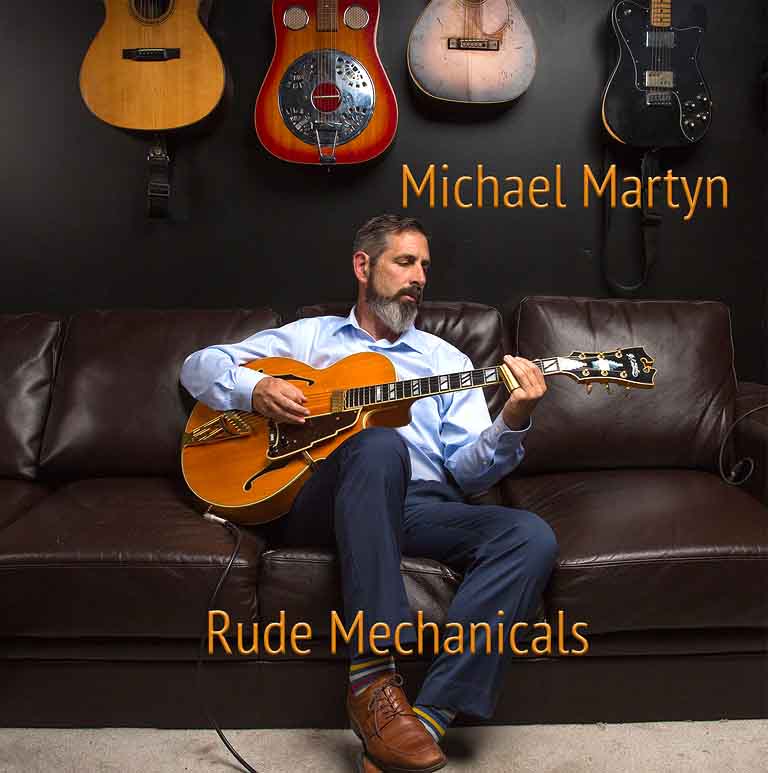
Steve used the same method for Michael Martyn’s Rude Mechanicals album too.
“I put together a session band for him,” Steve said. “We did produce his album quite extravagantly. There’s a lot of extra tracks on there, the B3, the piano, the three or four guitar tracks on each song.”
Being a producer is kind of like looking at tubs of ice cream at the Sweet Dreams booth, producers come in many flavours with some just handling the paper work and musician contracting all the way through to writing and arranging, even playing on a recording. The level of influence on the final product varies.
“We do everything from helping them to lay out what exactly it is they want to accomplish, to pulling it all together, to bringing in session musicians if they are needed in certain areas, and of course taking them through the whole recording process, which most people are kind of green on. It can be an overwhelming process,” said Steve.
“That’s why we are so conscious of keeping the environment the way we want it to be, keeping it comfortable, not rushed, and be able to capture what we you want to capture. That’s’ just getting the product ready. Then where Marni is incredibly valuable is her assistance to help with the whole social media marketing campaign. Then we help with lining up to get CD production, or if they going to do vinyl, or digital distribution, taking it right from A to Z, right through the whole process, which can be so overwhelming for most.”
“The creativity of it, that’s a huge component of it. But, I always try to be mindful that I never want to direct; what are you looking for as an artist, what do we need to do to help that sound great. I’ll never say, “we’ve got to cut 45 seconds out of that bridge because we got to get it under 3 minutes and 30 seconds so it gets on radio. I never want to jeopardize the art for that.”
“It’s the artist’s music and I want to make sure whatever we are working on together they can live with for the rest of their lives because it lasts forever. Once it’s done – you can rush through it and do whatever you want, but you’ve got to live with that – you either love it or you hate it,”
That doesn’t mean he won’t make a suggestion or two.
“I can’t tell you how many tracks we do where we’ll put a mandolin or whatever in and then it’s like, let’s listen to it again, and it was fine without it,” Steve said.
They like the idea of being guides. The culmination of the desire to pick up where they left off as teenagers combined with their years of business experience, the lessons they can employ and pass on is enthusiastic and infectious. This turns the discussion toward younger musicians, what can be said to them about the journey.
“Thank goodness we went into this when we did in this stage of life because whatever would have happened earlier – probably not, because the music industry can eat you up,” said Marni.
“If we were doing what we’re doing when we were 23 and had the kids and everything; the visions of grandeur, you get a little bit of hope, this is going to take me places. You’re one in a million that happens to. To do it now at this stage of life where we have put the time and effort into establishing our careers, knowing that we’re providing the education for our kids, it’s so much more gratifying, we can enjoy the experience so much more,” said. Steve.
So, plan A and plan B is the order of the day.
“Set your goals. Depending on what you want to accomplish, you probably need to go out and get a job because this isn’t going to do that for you and it’s going to cost you to get to where you want to go,” said Marni.
“And then if success, if it comes, you can enjoy it,” said Steve. But young people are justifiably headstrong, and frankly have more time and don’t have many responsibilities, no fear, yet.
“That’s the advice we want to give them. Be the best guitarist you’ve ever heard, but yeah, if you want to be a full-time musician and you want to take this to where you need to be, go and learn. Invest at the same time into understanding what needs to be done and how you’re going to make it happen because everyone else will just take advantage of you. The more you can look after on your own, the better it’s going to be,”
“You always have to look out for your own best interests and the only way to do that is through education and understanding. Don’t get locked in thinking that you can slough that off. You’re ‘you incorporated.’ I don’t care if you are just the drummer in the band, the band’s a business; you’re in your own business too. You’ve got to look after every aspect of that business too,”
![]()



![]()
The New Album
For the Van Kessels, the roundabout journey back to the beginning has been on a road that coincidentally leads back to their neighbourhood park, Tudhope Park, and the Mariposa Folk Festival.
“Playing Mariposa this year, that’s a dream for us. To get invited and do our third album release there, it didn’t happen overnight. That’s taken the last decade of work on the side building a fan base and credibility, networking, including writing songs,” said Marni.
Even the best laid plans, like the ones for their new album can go south, but in this case it’s a trip south in freezing January – welcome. Their new album, Charm, wasn’t planned to be released for a little while, even though they released a video for their first single, What Tomorrow Will Bring. One can’t play a gig as big as Mariposa and not have the new album ready, so they moved into high gear and just this week got the CDs and vinyl records delivered. Fortunately they had the final mix done.
“Our last album was actually mixed in Paris, France. Stew Crookes, he’s done our last two albums. He lives in Paris now, he’s a Canadian,” said Steve. “When we were doing Terms and Conditions, I just loved his stuff. He’s done all of Doug Paisley’s stuff and Hawksley Workman, the Weather Station, a bunch of artists I really love.” Thanks to the internet everyone doesn’t have to be in the same room, or same city to work together.
“We did everything across the ocean.” Steve said. “He works on all the mixes, sends them back, then we have the Lacquer Channel’s (studio in Toronto) Phil Demetro, he does all the mastering.”
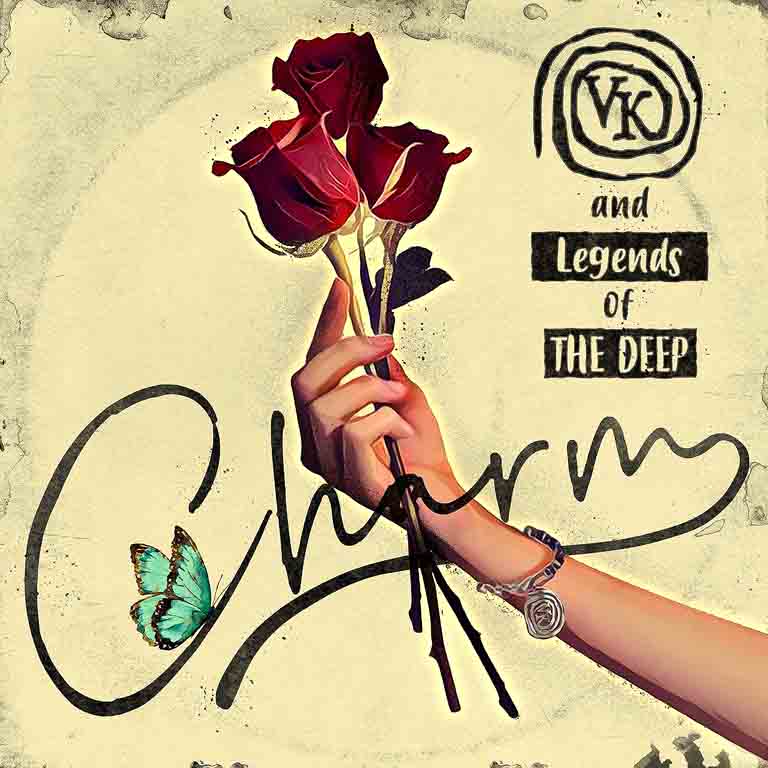
It’s the vinyl Steve is most enamoured with.
“These just came in yesterday,” Steve said, proudly showing of the album. “It was down to the wire getting the vinyl. We thought we were going to be down almost to the day before Mariposa, but they got it done quicker.” It’s the process of listening to music from the turntable Steve enjoys.
“You put an album on, you sit on a couch and listen to side A, you might nod off for 30 seconds, you get up, flip it over, you take time, you read the lyrics on the sheet, you read all the production notes. Today, especially kids and stuff, it’s downloaded from Apple, or even stream it, you listen for 30 seconds and then boom, you’re on to the next one. You’d knew every word to every single song on that album inside and out intimately. Now we’ve got 35,000 songs on our phones, let alone what you have on your computer.”
But the reality is, it’s a niche market, and Marni has a handle on what is needed today.
“You’ve got to have that digital download with everything because there’s a select few of us that want to have that experience (vinyl) or want a CD experience, and the rest, they all want the digital download,” Marni said. Then they turn attention to what many feel is the lost art of producing a record, the album cover.
“We’ve got a lot of symbolism in our album cover. We’ve got the VK charm to represent Marni and I,” said Steve.
“We’re charmed,” said Marni with a laugh. “And it’s the third album.”
“Third time’s the charm, right? It all ties together,” Steve agreed.
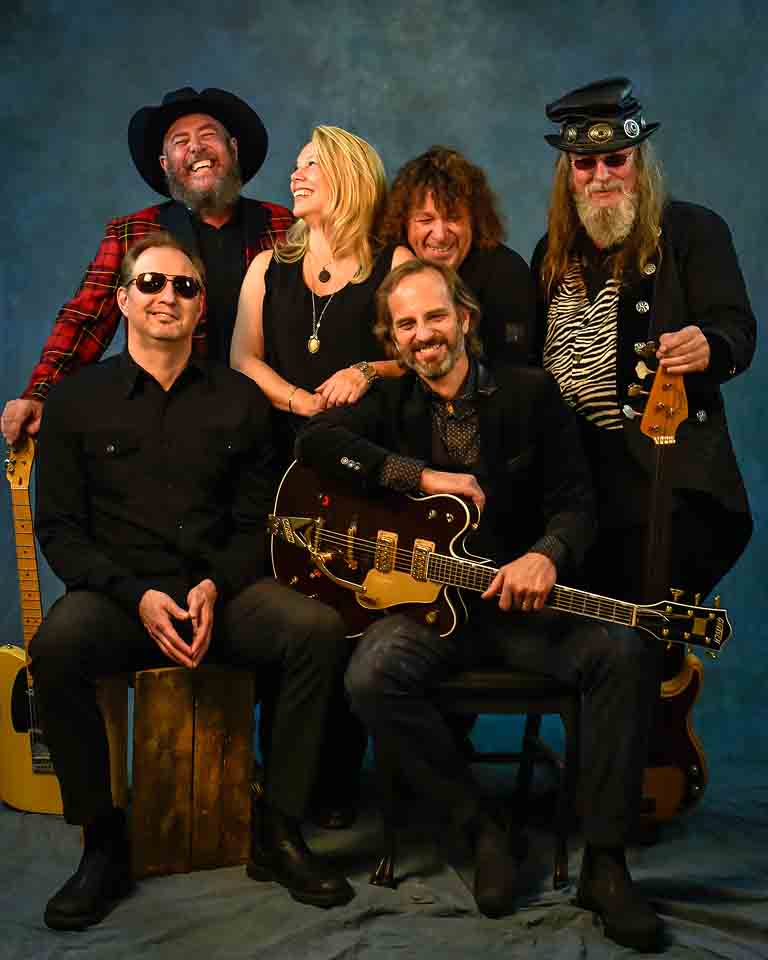
Central to the design are three burgundy coloured roses, which means something too.
“We wanted to symbolize them (John Lebarr, Jayme Heidman and Roger Stanley) with the three roses. They’ve been playing together for 30 years” Steve said of sidemen who have also been known to the community as Burgundy Rose. And there’s a butterfly on the cover too.
“Sean, with REAY, his album is called Butterfly Tongue Revisited.” said Steve.
Playing at Mariposa also prompted them to move up the release of their intended second single, Letting Go.
“We’re doing this so quickly. Normally you’d wait two months and release the second single. Because Mariposa is coming up, we’re going to release Letting Go as the second single this coming Friday (June 21). It’s the first day of summer, this has got more of an upbeat, summery kind of a vibe,” said Marni. “It’s a really fun summer song.”
This is not unusual. Things happen in the performing arts and when things catch fire you have to be ready, or at least be in a position to get ready quickly. For the Van Kessels, their experience in business combined with their musical talent and knowledge worked on so many levels.
“Creating the record label and bringing on the artists we have, it’s something we do together and something we’re building together and we’re having a lot of fun doing,” said Marni. “It’s a lot of work building it up. None of this happens on its own. There’s hours and hours put in behind the scenes to make it all come together, but it is a labour of love.”
(Photos by Swartz – SUNonline/Orillia, and Marni Van Kessel )
EDIT: Fixed reference to Sean Murray as Keyboard player, not bassist.

